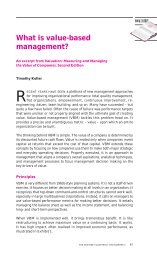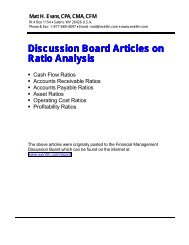Chapter I: Introduction to Data Mining
Chapter I: Introduction to Data Mining
Chapter I: Introduction to Data Mining
Create successful ePaper yourself
Turn your PDF publications into a flip-book with our unique Google optimized e-Paper software.
© Osmar R. Zaïane, 1999 CMPUT690 Principles of Knowledge Discovery in <strong>Data</strong>bases<br />
The most commonly used query language for relational database is SQL, which<br />
allows retrieval and manipulation of the data s<strong>to</strong>red in the tables, as well as the<br />
calculation of aggregate functions such as average, sum, min, max and count. For<br />
instance, an SQL query <strong>to</strong> select the videos grouped by category would be:<br />
SELECT count(*) FROM Items WHERE type=video GROUP BY category.<br />
<strong>Data</strong> mining algorithms using relational databases can be more versatile than data<br />
mining algorithms specifically written for flat files, since they can take advantage<br />
of the structure inherent <strong>to</strong> relational databases. While data mining can benefit<br />
from SQL for data selection, transformation and consolidation, it goes beyond<br />
what SQL could provide, such as predicting, comparing, detecting deviations, etc.<br />
• <strong>Data</strong> Warehouses: A data warehouse as a s<strong>to</strong>rehouse, is a reposi<strong>to</strong>ry of data<br />
collected from multiple data sources (often heterogeneous) and is intended <strong>to</strong> be<br />
used as a whole under the same unified schema. A data warehouse gives the<br />
option <strong>to</strong> analyze data from different sources under the same roof. Let us suppose<br />
that OurVideoS<strong>to</strong>re becomes a franchise in North America. Many video s<strong>to</strong>res<br />
belonging <strong>to</strong> OurVideoS<strong>to</strong>re company may have different databases and different<br />
structures. If the executive of the company wants <strong>to</strong> access the data from all s<strong>to</strong>res<br />
for strategic decision-making, future direction, marketing, etc., it would be more<br />
appropriate <strong>to</strong> s<strong>to</strong>re all the data in one site with a homogeneous structure that<br />
allows interactive analysis. In other words, data from the different s<strong>to</strong>res would be<br />
loaded, cleaned, transformed and integrated <strong>to</strong>gether. To facilitate decisionmaking<br />
and multi-dimensional views, data warehouses are usually modeled by a<br />
multi-dimensional data structure. Figure 1.3 shows an example of a three<br />
dimensional subset of a data cube structure used for OurVideoS<strong>to</strong>re data<br />
warehouse.<br />
Group By<br />
Category<br />
Drama<br />
Comedy<br />
Aggregate Horror<br />
Sum<br />
Sum<br />
Drama<br />
Comedy<br />
Horror<br />
By Time<br />
Cross Tab<br />
Q1 Q2 Q3 Q4 By Category<br />
Sum<br />
By City<br />
By Time & City<br />
By Category & City<br />
The <strong>Data</strong> Cube and<br />
The Sub-Space Aggregates<br />
Q1 Q2<br />
Q3 Q4<br />
Sum<br />
Red Deer<br />
Lethbridge<br />
Calgary<br />
Edmon<strong>to</strong>n<br />
By Category<br />
By Time<br />
Drama<br />
Comedy<br />
Horror<br />
By Time & Category<br />
Figure 1.3: A multi-dimensional data cube structure commonly used in data for data warehousing.<br />
University of Alberta page 6 Department of Computing Science
















